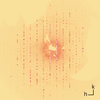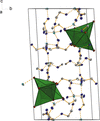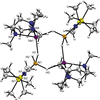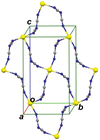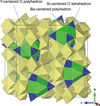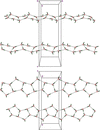issue contents
December 2022 issue

Cover illustration: Metal chalcogenides are usually synthesized by solid-state reaction of the constituent elements at high temperatures (500–1050 K). Fuss and Thiele report the structure of a chalcogenido ferrate, {[Li6(en)11.5][Fe4Se8]}n, prepared from Li, FeSe, and Se in ethylene diamine solution. This synthetic strategy provides easier access to chalcogenides with potential technological applications. See: Fuss & Thiele [Acta Cryst. (2022). E78, 1204–1208].
Jerry P. Jasinski tribute
The life and career of Jerry P. Jasinski are celebrated in a virtual special issue.
modern approaches and tools for teaching crystallography
Download citation


Download citation


The title amino-carborane {systematic name: closo-9-[4-(dibenzylamino)phenyl]-1,2-dicarbadodecaborane(12)}, C22H29B10N, crystallized with two molecules in the asymmetric unit which are closely related by pseudo-translation symmetry. With the correct unit-cell setting, the structure could be solved and refined without any problems and the final result is a non-disordered structure where all atoms could be localized successfully.
CCDC reference: 2216569
research communications
Download citation


Download citation


The title compound crystallizes in the same space group (P21/c) as the previously reported dihydrate form, but with two formula units per asymmetric unit instead of one. In the crystal, the components are linked into a three-dimensional network by classical intermolecular O—H⋯O and N—H⋯O hydrogen bonds and π–π stacking interactions.
CCDC reference: 2215274
Download citation


Download citation


The synthesis and crystal structure of the title mononuclear pyrazole-based complex, [Ni(C4H6N2)4Cl2]·2CH3CN, are reported along with the results of a Hirshfeld surface analysis.
CCDC reference: 2215549
Download citation


Download citation


The title compound comprises a 4-amino-1,8-naphthalimide core with a 2,2,6,6-tetramethyl-4-piperidinyl substituent bonded to each nitrogen atom and features varying bond lengths as a result of resonance.
CCDC reference: 2215550
Download citation


Download citation


In the crystal structure of the title compound, the copper(II) ions are monodentately coordinated by two neutral p-nitroaniline molecules through their amino nitrogen atoms, two NO3− anions and two water molecules.
CCDC reference: 2131922
Download citation


Download citation


The title complex adopts a square-planar structure, consisting of a C,N bidentate anion, an N-coordinating neutral ligand and a methyl ligand. The emission of the title complex originates from a ligand-centered π–π* transition mixed with a metal-to-ligand charge-transfer transition.
CCDC reference: 2216704
Download citation


Download citation


The charge-neutral title compound is a low-spin complex with a moderately distorted pseudooctahedral coordination environment of the metal ion. As a result of the cone shape, the molecules are stacked in one-dimensional columns that are bound by weak hydrogen bonds into layers, which, in turn, are arranged in a three-dimensional lattice bound by weak interlayer C—H⋯Cl interactions.
CCDC reference: 2216680
Download citation


Download citation


The macrocyclic metallacrown complex DyNa(2-PV)4[12-MCMnIIINshi-4](H2O)4·4DMF, where MC is metallacrown, shi3− is salicylhydroximate, 2-PV is 2-propylvalerate, and DMF is N,N-dimethylformamide, contains an [MnIII—N—O] repeat unit. A DyIII ion is captured on the convex side of the central MC cavity, while an Na+ ion is captured on the concave side. Four 2-propylvalerate anions bridge between each ring MnIII ion and the central DyIII ion.
CCDC reference: 2216645
Download citation


Download citation


The crystal and molecular structures of N-(2-fluoroethyl)-1-[(6-methoxy-5-methylpyrimidin-4-yl)methyl]-1H-benzo[d]imidazole-4-carboxamide, a non-covalent inhibitor of the mycobacterial enzyme DprE1, are reported.
CCDC reference: 2216847
Download citation


Download citation


The molecular and crystal structures of the title complex, cis(S),trans(O,Nbpy)-[Ru(bpy)(ppk)(dmso-S)2](OTf)2 (bpy = 2,2′-bipyridine, ppk = phenyl-2-pyridyl ketone, dmso = dimethyl sulfoxide, and OTf− = trifluoromethanesulfonate), are reported. The Ru2+ ion has a distorted octahedral geometry with two bpy N atoms, the N and O atoms of ppk, and two S atoms of two cis dmso-S ligands.
Download citation


Download citation


The title compound was prepared from dibenzo[c,e]oxepine-5(7H)-one and Lawesson's reagent in refluxing toluene. The structure is comprised of a network of C—H⋯S and C—H⋯π interactions. No π–π interactions between ring moieties were observed, most likely due to the lack of molecular planarity.
CCDC reference: 2216808
Download citation


Download citation


The crystal structures of two benzenesulfonyl-carbazole derivatives are described and the intermolecular contacts in the crystals analysed using Hirshfeld surface analysis and two-dimensional fingerprint plots.
Download citation


Download citation


The hexalithium ethylenediamine octaselenido tetraferrate was synthesized in solution, to be the first lithium-containing compound with chalcogenido tetraferrate cluster anions.
CCDC reference: 2217266
Download citation


Download citation


In the copper–mefenamate complex, the asymmetric unit comprises a CuII cation coordinated to two mefenamate ligands solvated with a water molecule and diglyme molecule. The complex adopts a paddlewheel motif and is compared to structural analogues crystallized with dimethylformamide and dimethyl sulfoxide.
CCDC reference: 2217265
Download citation


Download citation


The synthesis and X-ray structure of title dimeric oxidomethoxovanadium(V) complex are reported. Within the centrosymmetric edge-shared dioctahedral structure, each metal center is in a distorted octahedral NO5 environment.
CCDC reference: 2218751
Download citation


Download citation


Thie structures of three hydride-bridged sodium aluminate compounds containing the utility amide N(SiMe3)2 are reported. One is a dihydride monomer and the others are both based on (AlHNaH)2 eight-membered rings, one being a dihydride and one a trihydride.
Download citation


Download citation


The title compound consists of a layered {[Cd3Cl10]4–}∞ network with p-methylanilinium cations situated between the layers to which they are hydrogen bonded: it can be described as a two-dimensional organic–inorganic hybrid perovskite.
CCDC reference: 922195
Download citation


Download citation


A metabolite of an anabolic steroid norchlorotestosterone acetate (NClTA) was successfully synthesized and characterized by 1H NMR and 13C NMR spectroscopy and single-crystal X-ray diffraction. The position of the chlorine substituent and the absolute configuration of the molecule were established.
CCDC reference: 2130048
Download citation


Download citation


The crystal structure of the title compound consists of discrete complexes with approximately square-pyramidal Hg2+ coordination. Offset face-to-face π–π stacking and other intermolecular interactions were investigated with Hirshfeld surfaces and fingerprint plots.
CCDC reference: 2219283
Download citation


Download citation


Two new cadmium complexes both form two-dimensional coordination polymers in which polymitrile ligands act as bridges between pairs of metal centres, forming 24-membered rings.
Download citation


Download citation


The crystal and molecular structures of the azoxy derivative of the antitubercular agent 8-nitro-2-(piperidin-1-yl)-6-(trifluoromethyl)-4H-benzo[e][1,3]thiazin-4-one are reported.
CCDC reference: 2219153
Download citation


Download citation


Single crystals of a new quaternary oxide, barium hexadecayttrium tetrasilicon tritriacontaoxide, BaY16Si4O33, were obtained from a melt-solidified sample prepared by heating a mixture of BaCO3, Y2O3, and SiO2 at 2073 K. The dielectric constant measured for polycrystalline ceramics of BaY16Si4O33 sintered at 1953 K was 13 (298 K, 1 MHz), and the thermal expansion coefficient was 8.70 × 10 −6 K−1 (298–873 K), which are close to the values previously reported for Y2O3.
CCDC reference: 2220459
Download citation


Download citation


Two structurally different zinc(II) ions are present in the asymmetric unit of the title compound. The first exhibits a distorted tetrahedral environment formed by the O atoms of the carboxylate and nitrate anions, while the coordination environment of the second ion corresponds to a distorted octahedron formed by the O atoms of carboxylate groups and the 1-methylpyrrolidin-2-one molecules. The carboxylate anions bind the binuclear zinc-containing building units into a three-dimensional polymeric coordination network.
CCDC reference: 2217788
Download citation


Download citation


The syntheses and crystal structures of three organic salts of sparfloxacin are described. Crystals of the salt with 4-methylbenzoate incorporate extended chains of fused water pentagons, reminiscent of an exotic form of linear `ice' that forms of the Cu(110) surface at low temperature.
Download citation


Download citation


The asymmetric unit of the title compound contains two molecules differing slightly in the rotational orientations of the methyl groups.
CCDC reference: 2221106
Download citation


Download citation


In the reaction of 2,5-dimethyl-1H-benzimidazole and 2-n-butyl-5-chloro-1H-benzimidazole with substituted benzenesulfochloride, the formation of two products was observed for two of the compounds reported, as a result of the tautomerism of benzimidazoles. The main differences between all the compounds reported pertains to the arrangement of the benzimidazole and arylsulfonyl fragments.
Download citation


Download citation


A way to crystallize the 2-aminobenzoxazole–fumaric acid (1:1) co-crystal in the form of a molecular salt was proposed. Its structure was analysed from topological (Hirshfeld surface analysis) and energetic approaches (analysis of the distribution of pairwise interaction energies).
CCDC reference: 2221183
Download citation


Download citation


Lithium thiocyanate and succinonitrile form a solvate structure namely, catena-poly[lithium-di-μ-thiocyanato-lithium-di-m-butanedinitrile].
CCDC reference: 2220707

 journal menu
journal menu












